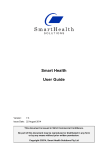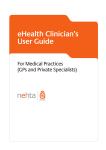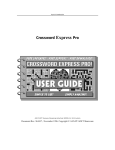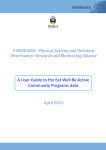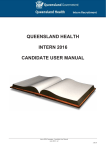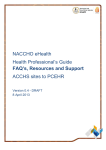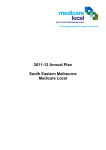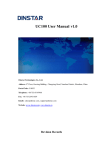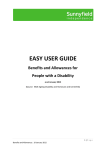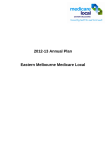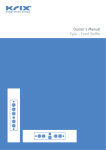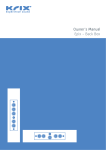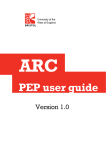Download Medicare Local Annual Plan template and user guide
Transcript
2012-13 Annual Plan Southern Adelaide-FleurieuKangaroo Island Medicare Local Document History Version No. 1 Date 18th May 2012 Description of Revision 2012-13 Annual Plan for Southern Adelaide-Fleurieu-Kangaroo Island Medicare Local 1 Table of Contents Checklist and Attachments ...................................................................................... 2 Annual Plan Checklist ........................................................................................ 2 Attachments ...................................................................................................... 2 1 Organisational overview .................................................................................... 3 1.1 Medicare Local contact information............................................................ 3 1.2 Medicare Local region characteristics ........................................................ 4 1.3 Organisational structure and internal governance ...................................... 8 1.4 Board membership................................................................................... 11 1.5 Company membership ............................................................................. 13 1.6 Company objects ..................................................................................... 14 1.7 Key stakeholder relationships .................................................................. 16 1.8 Subcontractors......................................................................................... 25 1.9 List of attachments ................................................................................... 26 2 Medicare Locals Core Funding Program ......................................................... 27 2.1 Key activities ............................................................................................ 27 2.2 Risk management plan – Medicare Local core funding program .............. 36 2.3 Transition arrangements .......................................................................... 37 2.4 Additional Program information or Program material .. Error! Bookmark not defined. 3 Medicare Local After Hours Program .................. Error! Bookmark not defined. 3.1 Key activities ............................................... Error! Bookmark not defined. 3.2 Risk management plan – Medicare Local After Hours Program ..........Error! Bookmark not defined. To automatically update the Table of Contents when changes have been made within the Annual Plan: right-click in the centre of the table of contents and select “Update Field”, then “Update entire table”. 2012-13 Annual Plan for Southern Adelaide-Fleurieu-Kangaroo Island Medicare Local 1 Checklist and Attachments Annual Plan Checklist A cover letter has been provided to the Department, confirming that the information in the Annual Plan is correct and has been approved by the Medicare Local’s Board of Directors. The cover letter should also acknowledge that it is an offence under Section 137 of the Criminal Code Act 1995 to provide false or misleading information or documents to the Commonwealth. All parts of the Annual Plan template have been completed and the personnel completing and authorising the plan have reviewed the Department’s instructions, rationale and assessment outline set out in the plan template. The plan includes page numbers. Activities are uniquely numbered (refer to the Instructions under Section 2.1 – Key Activities). Suggested sections not for public release are highlighted for consideration by the Department (refer to “Submission of the 2012-13 Medicare Locals Annual Plan & Annual Budget”). A correctly rendered invoice for the associated payment has been submitted (refer to Deed Schedule 1, Item E, General Invoice Provisions). The Annual Plan will be posted on the Medicare Local’s website once approved by the Department (and once the sections not for public release have been removed) (refer to “Submission of the 2012-13 Medicare Locals Annual Plan & Annual Budget”). Template guidance set out in blue text has been removed. Attachments The following attachments have been included: Organisational chart(s) A copy of the Medicare Local’s full Constitution A copy of certificates of currency for all required Insurances (refer to Section 1.9) A copy of the register of Assets (refer to Section 1.9) Any other attachments listed under Section 1.9 2012-13 Annual Plan for Southern Adelaide-Fleurieu-Kangaroo Island Medicare Local 2 1 Organisational overview 1.1 Medicare Local contact information Medicare Local name: Southern Adelaide-Fleurieu-Kangaroo Island Medicare Local Medicare Local legal name (if different): Southern Adelaide-Fleurieu-Kangaroo Island Medicare Local Limited ABN: 19 154 865 835 Postal address: Box 1, Level 2A, Mark Oliphant Building 5 Laffer Drive BEDFORD PARK SA 5042 Street address: Level 2A, Mark Oliphant Building 5 Laffer Drive BEDFORD PARK SA 5042 Phone: (08) 8374 7000 Fax: (08) 8299 0362 Email: [email protected] Website: www.safkiml.com.au Branch office information: Rural Office: 2 McKinlay Street VICTOR HARBOR SA 5211 Headspace Office: 16 Alexander Kelly Drive NOARLUNGA SA 5168 CEO Deb Dutton, Chief Executive Officer (permanent) Email: [email protected] Phone (08) 8374 7000 or 0434 275 543 Annual Plan contact: Deb Dutton, Chief Executive Officer Email: [email protected] Phone (08) 8374 7000 or 0434 275 543 2012-13 Annual Plan for Southern Adelaide-Fleurieu-Kangaroo Island Medicare Local 3 1.2 Medicare Local region characteristics The Southern Adelaide-Fleurieu-Kangaroo Island (SAFKI) Medicare Local has several distinct communities within its catchment. These communities range from urban (metropolitan and highly populated areas), to peri-urban (where new growth is rapid and human services often fail to keep up with needs), to rural areas, inclusive of the remote area of Kangaroo Island (which is extremely isolated and is a distinct community in its own right). Current population analysis The region comprises a population of 391,501. 12% of the region’s populations live in rural or remote areas (Country Health SA Health Service area) and 88% of the region’s populations live in metropolitan areas (Southern Adelaide Health Service region). The SAFKI Medicare Local region covers the areas of the Southern Adelaide Local Health Network and the Country Health SA Local Health Network. Key features of the region: Almost equal male/females A lower percentage of younger people and a higher percentage of older people than the national population. Almost a quarter of the region’s population aged 65 years and above lives in the country areas. Pockets of disadvantage exist. The Outer Southern area is the most disadvantaged, which includes the two most disadvantaged statistical local areas (SLAs) in the region (Onkaparinga Hackham and Onkaparinga North Coast). The areas of highest disadvantage have generally higher rates of unemployment and income support. This is very evident in the Outer Southern area, which has the highest percentage of welfare dependent and other low-income families with the highest percentage of children in these families. The region has a relatively small population of identified Aboriginal people (less than 1% compared to 3.3% nationally). 8.2% of families are single parent families with children aged less than 15 years. However, there are pockets where these figures are much higher, for example, in four of the five SLAs in the Outer Southern area of the region this figure rises to between 11.6% and 14.2%. The proportion of jobless families with children aged less than 15 years follows a similar trend, as does the percentage of children in jobless families. The number of migrant residents in the region is similar to the national average. 2012-13 Annual Plan for Southern Adelaide-Fleurieu-Kangaroo Island Medicare Local 4 The percentage of pensioners (males aged 65 years and over and females aged 63 years and over) is higher than the national average; the percentage of pensioners is highest in the Outer Southern area. The estimated unemployment rate is higher than the national but comparable to State. However, unemployment beneficiaries are comparable to National and slightly below the State average with higher rates of benefit to the population in disadvantaged areas and some of the rural areas. Children living in the region fully immunised at 12 to <15 months of age is 92.1%. The SAFKI Medicare Local region has 14,973 people with diabetes and more than 31,561 patients with high cholesterol; both ranking as the second highest of the Medicare Locals in South Australia. Just under 43,890 patients have mental and behavioural problems as identified from data direct from general practices. Almost 34% of the population, 113,434 patients, has respiratory disease; one third of these, 37,837 patients, have asthma, 10,020 have chronic obstructive pulmonary disease. 34% of the population has musculoskeletal system diseases, (132,574 patients); eight percent of these patients have either arthritis, (65,455) patients, or osteoarthritis, (38,961) patients. The 2007-2008 National Health Survey (NHS) reported 54,037 patients aged 18 and above, 14% of the population, as current smokers. This increases to over 20% in most of the lower socio-economic and country areas in the region. The Outer Southern area has the highest rate per 100 persons 18 years and over with at least one of four of the following health risk factors - smoking, harmful use of alcohol, physical inactivity, obesity. 2012-13 Annual Plan for Southern Adelaide-Fleurieu-Kangaroo Island Medicare Local 5 1.3 Strategic Direction VISION Healthy local communities through excellence in integrated primary health care (PHC). MISSION In working towards excellence in health care for our communities, we will strive to be the best Medicare Local we can be by: Developing integrated and coordinated services Supporting Clinicians and service providers to improve patient care Identifying needs and developing locally focused and responsive services Facilitating successful primary health care initiatives and Programs Demonstrating strong governance, effective management and investing in the well-being and development of our staff Embracing and being responsive to opportunities and challenges. STRATEGIC DIRECTION The strategic direction of the organisation can be summarized by the Key Areas of Focus for 2011-14 being: 1. Promoting and maintaining good health and wellbeing in our communities Healthy communities in the SAFKI Medicare Local region will be developed through initiatives that promote good health and wellbeing and encourage prevention of disease. SAFKI Medicare Local acknowledges it has a role in advocating for better health and wellbeing for all and in particular, for the most disadvantaged members of our communities. 2. Driving innovation in primary health care practice and service delivery SAFKI Medicare Local will generate new ideas to make primary health care practice and delivery the best it can be in our region. In our drive for innovation we will focus on (but not restrict ourselves to) information management and technology (IM&T) and workforce sustainability. 3. Constructing an accessible, integrated health care system To improve access to and integration of primary health care services we will design, develop and implement clinical pathways that create optimal patient experiences and rapid responses. SAFKI Medicare Local will focus on (but not be restricted to) advancements for the aged care and mental health sectors. We will pay careful attention to ensure services are not duplicated when targeting gaps in service provision. 4. Incorporating population health principles and practices into our business This will be our way of doing business. This approach will identify gaps to inform our future strategy including how, and where, we do business. It will evaluate the outcomes of our activities and approaches and will involve close engagement with our communities and key stakeholders in a meaningful way. 2012-13 Annual Plan for Southern Adelaide-Fleurieu-Kangaroo Island Medicare Local 6 5. Promoting the development of new knowledge and understanding the impact of our work through research and evaluation We believe that research, evaluation and continuous development underpin, inform and support the way in which we work: all programs and services. Activities in this direction inform future initiatives and enhance our capacity to share important achievements with others. 6. Delivering on patient safety and clinical quality improvement in primary health care practice Safety and quality are recognised as critical components in the provision of primary health care for our communities. Evidence based practice, partnering with consumers and improved clinical handover are our target areas for driving safety and quality in primary health care in our region. 7. Creating a dynamic organisation As a new organisation SAFKI Medicare Local has an opportunity to establish high standards and create a dynamic culture at all levels. Best practice governance will provide a solid foundation for excellence in management and business operations. We acknowledge our vision will not be achieved without the hard work and dedication of a highly motivated and effective team. We therefore are fully committed to supporting the well-being, safety, education and development of our staff. 2012-13 Annual Plan for Southern Adelaide-Fleurieu-Kangaroo Island Medicare Local 7 1.4 Organisational structure and internal governance 2012-13 Annual Plan for Southern Adelaide-Fleurieu-Kangaroo Island Medicare Local 8 SAFKI Medicare Local ORGANISATION CHART Board Committees 1. Nominations & Governance 2. Finance & Audit 3. Community Governance 4. Clinical Governance BOARD Executive Officer Leadership and Advisory Group (Clinicians & Consumers) Chief Executive Officer BUSINESS OPERATIONS Executive Clinical Director PROGRAMS & SERVICES BUSINESS DEVELOPMENT Senior Manager, Support Services Financial Controller Senior Business Manager Finance Team Support Services Team Senior Policy, Planning, Research Service Development Manager Senior&Clinical Manager Senior Programs Manager Clinical Services Advisor Corporate Communications Advisor Primary Health Care Services Team Clinical Services Team Aged Care Services Manager Senior Information Manager IM&T Team Business Development Advisor (After Hours) Population Health Manager Aged Care Services Team (Reach) 2012-13 Annual Plan for Southern Adelaide-Fleurieu-Kangaroo Island Medicare Local 9 Key: Organisational level Governance level Regional level 3 x Directors (one as chair) 3 independent CEO & ECD (ex-officio) Board of Directors Clinical & Community Governance Committee 3 x Directors (one as chair) 5 x independent external members (3 x clinicians and 2 x consumers) CEO & ECD (ex-officio) Meet quarterly Assurance to the Board that appropriate organisational structures, processes and resources are in place to monitor, manage and improve patient safety and service delivery. Nominations Committee 2 x Directors 2 x independent external governance consultants (one as chair) Corporate Governance Committee Finance, Audit, Risk & Compliance Committee 3 x Directors (one as chair) CEO (ex-officio) Meet quarterly 3 x Directors (one as chair) CEO & Financial Controller (ex-officio) Meet quarterly Meet quarterly or as required Manages and performs Board recruitment and selection process including nomination process from membership. Board succession planning. Ensure that the organisation supports a democratic, fair, accountable range of services, which accommodates and values diversity, addresses the needs of vulnerable people, recognises regional and rural differences and contributes to demonstrable high quality outcomes in accordance with agreed standards across a range of settings. Alignment of the board’s operations with best corporate governance practice; Ensure financial & legislative compliance; Review of the effectiveness of committees; Internal controls, policies and financial disclosures; Overseeing the process for performance review of the board, the CEO and the chair; Integrity and quality of the organisation’s financial information including that to stakeholders; Assessing management of board conflicts of interest; Work around strategic planning; Selecting the auditor, the independence, objectivity, scope and quality of the external audit; and Board professional development; CEO selection and succession planning; and Board remuneration and risk management (insurances). Membership application and approval process. Chief Executive Officer Local Lead Clinicians Group Clinical & Consumer Reference Pool A pool of clinicians and consumers called upon periodically in groups to provide specific input into the ‘grass root’ activities of the organisation. For example: a small group of people would meet to discuss the specific areas to be addressed in an Education Session. 12 members in total (75% clinicians, 25% consumers) 4 x Medicare Local reps 4 x Local Health Network reps 4 x advertised positions (includes private hospitals) 2012-13 Annual Plan for Southern Adelaide-Fleurieu-Kangaroo Island Medicare Will focus on regional issues: Safety and quality; Integration and Local Pathway development. 10 1.5 Board membership Position on board Name Expertise Profession Date of Appointment 1. Chair Laureen Lawlor-Smith General Practice General Practitioner 1st January 2012 Corporate Governance Business Local health Manager care provider and community knowledge (particularly rural) 2. Director Lisa Bishop Business Management (particularly finance, marketing and human resources) Business Consultant 1st January 2012 Professor, Flinders University 1st January 2012 Corporate Governance Risk Management 3. Director Richard Reed Population Health Health Education Clinical General Practitioner Corporate Governance 4. Director Ray Creen Local health care knowledge Business Management Community Governance Chief Executive Officer, SA Ambulance Service 1st January 2012 Emergency Medicine Paramedic 2012-13 Annual Plan for Southern Adelaide-Fleurieu-Kangaroo Island Medicare Local 11 Clinical 5. Director David Ng Primary Health Care Local health care knowledge 6. Director John Guy Branch 1st January Director 2012 Pharmaceutical Society Australia SA/NT branch Corporate Governance Pharmacist General Practice General Practitioner 1st January 2012 Local health Business care provider Manager and community knowledge (particularly metro) 7. Director Carolyn Astley Health system redesign & change management Clinical governance Clinical Effectiveness Manager, Flinders Medical Centre 1st February 2012 Clinical Nurse Research 8. Director Allen Bolaffi Accounting, finance & auditing Corporate Governance Chartered Accountant & Registered Company Auditor 1st February 2012 Board Director Transitional arrangements for Board appointments Not Applicable 2012-13 Annual Plan for Southern Adelaide-Fleurieu-Kangaroo Island Medicare Local 12 1.6 Company membership Membership structure SAFKI Medicare Local has one class of membership and membership is free of charge. The first member of the Company is General Practice Network South Incorporated and the other 19 members are general practices; however, as part of the Marketing & Membership Plan, a structured plan is being implemented that will enable membership to cover the full range of primary health care providers within our Medicare Local area and the broader local community. Full coverage of primary health care providers and the local community is not initially possible - membership will grow over time. As per the SAFKI Medicare Local constitution: “A member shall be an organisation (by definition, hold an Australian Business Number and other than a natural person. To avoid doubt, sole traders are not to be considered organisations) currently operating within the SAFKI Medicare Local region which shall meet one or more of the following criteria: (a) A group of Medical Practitioners, Nurses, Allied Health or other primary health care professionals; (b) An employer or contractor of medical practitioners, nursing, allied health professionals or other primary care professionals; (c) An educator or trainer of existing or potential medical practitioners, nurses, allied health professionals or other primary care professionals; (d) Government Authorities working or providing services within the SAFKI Medicare Local region; and (e) Such other entities which the Board deems appropriate and whose appointment would be in the interests of the Company in furthering the Objects.” The membership is integral in the appointment of the Board. After the Company's third annual general meeting the Directors shall comprise a majority of directors elected by the membership. The nominations committee shall assess the candidates nominated and endorse candidates for election by the members. 2012-13 Annual Plan for Southern Adelaide-Fleurieu-Kangaroo Island Medicare Local 13 Category Number of Organisational Members Number of Individual Members Medical General Practice 19 Other 1 1.7 Company objects The objects of the Company are to: 1.7.1 Improve the health of the Local Communities and achieve measurable health improvement outcomes; 1.7.2 Promote and enhance primary health care and the centrality of general practice for the delivery of effective integrated health management for the local community; 1.7.3 Promote, encourage, support and develop prevention, early intervention and control of diseases in human beings; 1.7.4 Encourage, support and initiate improvements in the delivery, coordination and integration of primary health care services including initiatives aimed toward improving disease prevention and management, raising patient awareness and improving access to appropriate services; 1.7.5 Improve the planning of primary health care services at a population level to identify and advocate for health needs of the community, develop locally focused and responsive health services and address service delivery gaps; 1.7.6 Provide support to Primary Health Care Clinicians and Primary Health Care Service Providers to promote safety and quality of health care; 1.7.7 Establish effective collaborations to deliver more coordinated, integrated, flexible and locally responsive health services; 1.7.8 Promote a culture of efficiency, accountability and continuous improvement in the delivery of primary health care services; 1.7.9 Foster, promote and participate in development, education and training; primary health care research, 1.7.10 Ensure the present and future primary health care workforce have the capacity and capabilities to deliver on improved disease prevention, control 2012-13 Annual Plan for Southern Adelaide-Fleurieu-Kangaroo Island Medicare Local 14 and management; 1.7.11 Partner with consumers and the community to improve the health and wellbeing of people within the Local Communities; 1.7.12 Do all such other things as may be incidental to the attainment of the above objects. 2012-13 Annual Plan for Southern Adelaide-Fleurieu-Kangaroo Island Medicare Local 15 1.8 Key stakeholder relationships SAFKI Medicare Local has a series of key mechanisms in which they intend to engage with stakeholders, as described below: 2.2.1 Patients and consumers (including Aboriginal and Torres Strait Islander representatives) SAFKI Medicare Local will: a. Maintain the SAFKI Medicare Local Leadership and Advisory Group (LAG) A pivotal ongoing engagement strategy is the SAFKI Medicare Local LAG. It will be a group of Clinicians and Consumers (incorporating a broad representation of allied health primary health care providers and consumers) that meet on a monthly basis that have direct input into the operations of the organisation at an organisational level. The group provides advice on mechanisms for engagement as well as input into operations at an operational level. Membership will include consumers, private and public sector allied health clinicians from the following professions: physiotherapy, diabetes education, dietetics, general practice, nursing, pharmacy, psychology, dental and optometry. b. Establish the Clinical & Consumer Reference Pool This will be a “pool” of Clinicians and Consumers of up to 40 people that are called upon periodically in groups to provide specific input into the ‘grass roots’ operations and activities of the organisation at team level within the organisation. These people will be used for input into specific areas. c. Develop the new SAFKI Medicare Local website The SAFKI Medicare Local website (which will include a primary health care service directory, in some form) will be a vital 24/7 communications/marketing tool to engage existing and potential PHC stakeholders and health consumers and will deliver expected outcomes such as current local service directories, clinical pathways and resources. Adding new sections (e.g. For consumers and For Health Professionals) will help to promote broader understanding of SAFKI Medicare Local’s work and provide information to assist providers and consumers to better access the services they need. d. Establish Board Committees including patients and consumers The Board of SAFKI Medicare Local will establish a Clinical & Community Governance Committee. This group will include 3 x Directors (one as chair), 5 x independent external members (3 x clinicians and 2 x consumers) and the CEO & ECD (ex-officio). The group will meet quarterly and provide assurance to the Board that appropriate organisational structures, processes and resources are in place to monitor, manage and improve patient safety and service delivery. The group will also ensure that the organisation supports a democratic, fair, accountable range of services, which accommodates and values diversity, addresses the needs of vulnerable people, recognises regional and rural differences and 2012-13 Annual Plan for Southern Adelaide-Fleurieu-Kangaroo Island Medicare Local 16 contributes to demonstrable high quality outcomes in accordance with agreed standards across a range of settings. The recruitment to this Committee will be a transparent public process. e. Participate in community forums: Involvement in or convening relevant community forums will provide an opportunity to listen to local community issues, respond to unmet needs and promote understanding of SAFKI Medicare Local’s role in addressing regional PHC issues. f. Develop and implement a media relations strategy: Media attitudes are critical and strategic media management will be a major aspect of the overall communications and engagement plan. Establishing a sound media relations strategy focusing on health, political and social issues journalists will assist in enhancing SAFKI Medicare Local's profile within the health sector, PHC providers, special interest communities and the broader community. The focus will be on highlighting key initiatives, consultations and service improvements. Key strategies include: Organising regular briefings with key journalists/editors Developing a schedule of proactive media releases suited to community, mainstream, industry and social media outlets Developing editorial articles for targeted health sector journals or newsletters. g. Develop a plan for the use of social media: The use of Facebook, YouTube, Twitter and other social media tools to share health messages has grown significantly, and continues to trend upward rapidly. Using social media is an effective way to expand reach, foster engagement and increase community access to credible, evidence-based health messages. Integrating social media into its health communication campaigns and activities will allow SAFKI Medicare Local to leverage social dynamics and networks to encourage participation, conversation and community – all of which can help spread key messages and influence health decision-making. Social media also helps to reach people when, where and how they want to receive health messages delivered. Likewise, tapping into personal networks and presenting information in multiple formats, spaces, and sources helps to make messages more credible and effective. SAFKI Medicare Local will be strategic and assess demographic and user data to make choices based on audience, communications objectives and key messages. SAFKI Medicare Local will start with a low risk strategy such as posting links to PHCrelated podcasts or videos on the SAFKI Medicare Local website and developing a Facebook page. Initial strategies may be led by Noarlunga headspace which must use social media to connect with youth. h. Participate in conferences and expos: Exhibitor displays will be an opportunity to reach a targeted and interested audience. SAFKI Medicare Local will focus on one key event each year that will reach an identified audience (e.g. Council health expo, Aboriginal Health Day, raise awareness on a specific health issue). 2012-13 Annual Plan for Southern Adelaide-Fleurieu-Kangaroo Island Medicare Local 17 i. Engage Local Members of Parliament: Maintaining a high profile with local MPs, particularly in electorates in which a SAFKI Medicare Local service (e.g. headspace) or office is located will be a vital engagement mechanism. All MPs have a website and a community newsletter, providing an opportunity to research the issues impacting specific electorates. Community newsletters may also provide opportunities to profile positive local PHC initiatives (particularly if they offer a photo opportunity). j. Recruit to the new position of Advocacy, Community and Consumer Coordinator Role SAFKI Medicare Local’s role of Advocacy, Community and Consumer Coordinator is a vital mechanism for patient, consumer and community engagement. This role is primarily responsible for engaging with community to increase consumer participation, advocating for changes in policy and service development requirements and to support Primary Health Care providers to manage vulnerable populations in order to achieve improved community health outcomes. The position is responsible for developing and implementing community engagement strategies increasing consumer participation across all programs and services increasing access to Primary Health providers for disadvantaged and vulnerable population groups liaising across internal teams as required, to advocate for changes to policy and service development requirements for the best interests of consumers, the community and vulnerable populations supporting primary health care providers to manage vulnerable population groups in conjunction with the Health Promotion and Early Intervention Coordinator, develop and implement strategies to improve consumer wellbeing that includes improving health literacy and promoting self-management Systematically engaging with Primary Health Care providers to increase participation in education, training and quality improvement strategies, delivered through the Primary Health Care Services Team. k. Engage through the Closing The Gap Suite of Programs Effective delivery of the Australian Government’s Closing the Gap (CTG) initiative will engage the Aboriginal community within SAFKI Medicare Local region. l. Participate and promote research and evaluation: Inviting ongoing feedback from key stakeholder groups (consumers, organisational members, PHC service database) through structured questionnaires (e.g. online Survey Monkey, satisfaction surveys/interviews) will help to establish trends in current perceptions about, or awareness of, the role of SAFKI Medicare Local, value of its services, potential for improvement or expanded services and suggestions for improved engagement with each specific group. m. Develop a stakeholder distribution list: Maintaining a key stakeholder list will enable SAFKI Medicare Local to prioritise, track and measure the outcomes of communication and engagement strategies. 2012-13 Annual Plan for Southern Adelaide-Fleurieu-Kangaroo Island Medicare Local 18 These may include: Personal visits, staff presentations, briefings with information kit Distribution of newsletters, e-bulletins, resources. n. Develop a new newsletter: Stakeholder eNews: The traditional publications of gpns (Wednesday In The South and Success In Practice) will not be appropriate for all audiences of SAFKI Medicare Local. In addition to existing publications, SAFKI Medicare Local will develop and distribute a twice-yearly eNews to update key partners and influencers about: Key achievements/milestones Activity - simple graphs showing % improvement in key population health measures Relevant consumer story Joint initiatives with regional PHC providers/agencies Relevant media coverage Planned initiatives. o. Other strategies include: headspace and our immunisation program will target groups such as schools, child health services, sporting clubs and community groups Capitalising on health promotion opportunities in the community, such as Aboriginal festivals. Clinicians, health services providers and their representative bodies (across the spectrum of primary care, and where relevant secondary and acute care and Aboriginal and Torres Strait Islander representatives) SAFKIML will: a. Establish a Primary Health Care Database SAFKI Medicare Local will map all primary health care services and providers within our region and gather this information in database form. b. Establish the SAFKI Medicare Local Leadership and Advisory Group (LAG) A pivotal engagement strategy is the formation of the SAFKI Medicare Local LAG. It will be a group of Clinicians and Consumers (incorporating a broad representation of allied health primary health care providers and consumers) that meet on a monthly basis that have direct input into the operations of the organisation at an organisational level. The group provides advice on mechanisms for engagement as well as input into operations at an operational level. Current members include private and public sector allied health clinicians from the following professions: physiotherapy, diabetes education, dietetics, general practice, nursing, pharmacy, psychology, dental and optometry. 2012-13 Annual Plan for Southern Adelaide-Fleurieu-Kangaroo Island Medicare Local 19 c. Establish the SAFKI Medicare Local Clinical & Consumer Reference Pool This “pool” of up to 40 people will be developed in early 2012. This is a pool of Clinicians and Consumers that are called upon periodically in groups to provide specific input into the ‘grass roots’ operations and activities of the organisation at a team level within the organisation. These people are used for input into specific areas. d. Develop the new SAFKI Medicare Local website The SAFKI Medicare Local website (which will include a primary health care service directory, in some form) will be a vital 24/7 communications/marketing tool to engage existing and potential PHC stakeholders and health consumers and will deliver expected outcomes such as current local service directories, clinical pathways and resources. Adding new sections (e.g. For consumers and For Health Professionals) will help to promote broader understanding of SAFKI Medicare Local’s work and provide information to assist providers and consumers to better access the services they need. e. Establish Board Committees including Primary Health Care Clinicians The Board of SAFKI Medicare Local will establish a Clinical & Community Governance Committee. This group includes 3 x Directors (one as chair) 5 x independent external members (3 x clinicians and 2 x consumers) and the CEO & ECD (ex-officio). The group will meet quarterly and provide assurance to the Board that appropriate organisational structures, processes and resources are in place to monitor, manage and improve patient safety and service delivery. The group will also ensure that the organisation supports a democratic, fair, accountable range of services, which accommodates and values diversity, addresses the needs of vulnerable people, recognises regional and rural differences and contributes to demonstrable high quality outcomes in accordance with agreed standards across a range of settings. The recruitment to this Committee will be a transparent public process. f. Participating and promoting research and evaluation Inviting ongoing feedback from key stakeholder groups (consumers, organizational members, PHC service database) through structured questionnaires (e.g. online Survey Monkey, satisfaction surveys/interviews) will help to establish trends in current perceptions about, or awareness of, the role of SAFKI Medicare Local, value of its services, potential for improvement or expanded services and suggestions for improved engagement with each specific group. g. Establish a Member Database Under the new SAFKI Medicare Local Constitution, targeted, eligible member organisations (including existing general practices and all organisations that are primary health care providers) will need to be proactively contacted and provided with an information package that clearly outlines member benefits (e.g. voting rights and Board membership), the application, cost and approval process. h. Establish Primary Health Care Provider Service Recipient Register Using a database, this ‘register’ (to be given a marketable name) will be developed to track SAFKI Medicare Local’s engagement with and service delivery to eligible PHC 2012-13 Annual Plan for Southern Adelaide-Fleurieu-Kangaroo Island Medicare Local 20 providers (e.g. those registered with AHPRA and/or eligible to participate in billing MBS Primary Care Items). Eligible PHC providers in the region will need to be identified, prioritised and proactively contacted and given an information package that clearly details the practical (sustainable) services and support that SAFKI Medicare Local can provide. i. Develop and maintain a stakeholder distribution list: Maintaining a key stakeholder list will enable SAFKI Medicare Local to prioritise, track and measure the outcomes of communication and engagement strategies. These may include: Personal visits, staff presentations, briefings with information kit Distribution of newsletters, e-bulletins, resources. j. Increase distribution list of Publications: The distribution list for the regular publications of SAFKI Medicare Local (Wednesday In The South and Success In Practice) will be expanded to include all primary health care clinicians, health services providers and their representative bodies. Wednesday in the South: This weekly bulletin (currently general practice focused) will need to be formally evaluated and reviewed to realign its frequency, content, preferred publication method (e.g. change to web-based) and distribution to meet the needs of a broader PHC audience (e.g. organisational members and PHC provider service database). Success in Practice: This quarterly practice improvement publication (currently general practice focused) will have a formal evaluation and review to realign its frequency, content, preferred publication method (currently electronic) to meet the needs of the broader PHC audience. The above reviews may highlight the need for new media to meet the communications needs of specific audiences. This may include online website forums and social media. Medicare Local Bulletin: During the period January-June 2012, SAFKI Medicare Local will distribute regular monthly bulletins to update key stakeholders about the transition process, key priorities and changes to membership and service provision. k. Provide practice support to all primary health care clinicians and service providers in the region: An annual program of Primary Health Care practice visits (in person, by phone or email) will remain an important strategy in providing targeted information on key SAFKI Medicare Local programs and services that support population health priorities and in establishing and building personal and working relationships. The Practice Support Team (to be renamed the Clinical Practice Improvement Team) will need to be adequately resourced for this work. An important initial strategy in expanding the SAFKI Medicare Local’s practical support to PHC providers is a scoping exercise to identify, map and allocate PHC practices/providers in the region to the PHC Support Team using Statistical Local Areas (SLAs) or similar. 2012-13 Annual Plan for Southern Adelaide-Fleurieu-Kangaroo Island Medicare Local 21 This requires a well-planned and targeted process. l. Provide Multi-disciplinary Education and Networking opportunities: Education and networking events targeted to meet the specific needs of different members of the general practice and primary health care teams will be a central part of the SAFKI Medicare Local engagement strategy. A strategy to broaden the reach of the annual event calendar to include primary health care professionals will be developed and may focus on education around clinical pathways (e.g. back pain or stroke) that have a multi-D focus. Local Hospital Networks SAFKI Medicare Local will: a. Continue with existing and look for new opportunities to work collaboratively with the LHNs: SAFKI Medicare Local will continue to work with the LHN on key areas of work including that of Clinical pathways and referral work and other projects including the eReferral Tool. SAFKI Medicare Local will continue to work with the LHNs around emergency after hours, population health planning and mapping outpatient services. b. Implement Horizontal & Vertical Integration Strategies Horizontal and vertical integration strategies will be developed across the primary and tertiary sectors including positions on SAFKI Medicare Local governance committee for LHN representatives and positions on the LHN Advisory Committees for a SAFKI Medicare Local representative. c. Review and look for new opportunities for representation on regional, state and national PHC committees: To establish its leadership role and potentially influence regional policy development and decision-making, SAFKI Medicare Local will review its representation on targeted committees/forums. It will develop a series of relevant position papers that reflect the position and objectives of Medicare Locals. This will be posted on the website to support high level advocacy work. d. Conduct ministerial briefings: Ministerial briefings with the CEO and Board Chair will be introduced once or twice a year, prior to an election, as an issue arises or when State Ministers are assigned a relevant portfolio (health, social inclusion). This provides an opportunity to provide background material, highlight key outcomes and raise advocacy issues impacting a specific constituency. Identifying their respective advisers is also useful. 2012-13 Annual Plan for Southern Adelaide-Fleurieu-Kangaroo Island Medicare Local 22 Community organisations SAFKI Medicare Local will: Establish a dedicated position to support communication between SAFKI Medicare Local and community agencies Ensure community groups are represented on the Board Clinical and Community Committee Plan and facilitate quarterly round table meetings between SAFKI Medicare Local staff and relevant community agencies (as commenced in the SAFKI Medicare Local transition engagement plan) Publish agreed strategies and proposed new initiatives in partnership with other community agencies, on the SAFKI Medicare Local website Develop a database detailing all partner community organisations to enhance communication and provide relevant information to the community Drive reporting and/or communication protocols and pathways between SAFKI Medicare Local and community agencies Continue with existing groups in which engagement is existing including the headspace Consortium and the REACH multidisciplinary group. State/Territory government SAFKI Medicare Local will: Continue to provide input into health and other policy, needs assessments and planning to ensure representation of our regional needs and perspectives Seek partnerships with neighbouring Medicare Locals to respond to the development of health policy and service planning across the state Partner with the state government to develop shared approaches to safety and quality Facilitate ministerial briefings with the CEO and Board Chair. Researchers and educators SAFKI Medicare Local will: Expand our existing general practice medical student orientation program to that of primary health care workers Continue to engage researchers and educators through our CPD program Look for opportunities to partner in shared applications for research Complete an application to Australian Primary Health Centre for Research Innovation in partnership with the University of Melbourne for the establishment of a Centre for Research Excellence in Health Planning and Innovation in Medicare Locals Become identified as a key partner in primary health care workforce development Collaborate with the local Universities in the population health process in regards to local health data and research projects. 2012-13 Annual Plan for Southern Adelaide-Fleurieu-Kangaroo Island Medicare Local 23 Other key stakeholders SAFKI Medicare Local will: Through its Stakeholder Mapping Process and plan, together with its Communication Plan, will identify any other key stakeholders and engage appropriately. 2012-13 Annual Plan for Southern Adelaide-Fleurieu-Kangaroo Island Medicare Local 24 1.9 Subcontractors Name Program Services Value Enter the name of the proposed subcontractor Enter the name of the Program for which the subcontractor has been/will be engaged Enter details of the services the subcontractor will be performing and the timeframe for when the services are to be performed Enter the amount (GST inclusive) of the planned subcontract Tender process Other contracts/ arrangements Enter details of how the Enter details of any subcontractor was/will other contracts or be selected by your arrangements organisation. In the between your event that a organisation and the subcontractor has been subcontractor. selected directly, Details should show without an approach to the relevant Program the market, please and dollar amount provide information on (GST inclusive) the rationale Conflict of interest Enter details of any actual or perceived conflicts of interest, and how these are/will be managed by your organisation $ $ 2012-13 Annual Plan for Southern Adelaide-Fleurieu-Kangaroo Island Medicare Local 25 1.10 List of attachments Please note that you should not include the following two attachments on your website. When submitting the annual plan, please also attach the following documents: a copy of certificates of currency for all required Insurances (as described in Clause 26 of the Deed) [Please do not include on your website] a copy of the register of Assets (as described in Clause 19 of the Deed) [Please do not include on your website] a copy of your Medicare Local’s full Constitution 2012-13 Annual Plan for Southern Adelaide-Fleurieu-Kangaroo Island Medicare Local 26 2 2.1 Medicare Locals Core Funding Program Key activities Strategic Objective 1. Improving the patient journey through developing integrated and coordinated services 2012-13 Annual Plan for Southern Adelaide-Fleurieu-Kangaroo Island Medicare Local 27 SAFKI Medicare Local will: 2.1.1 Develop Clinical Pathway and Regional Guidelines SAFKI Medicare Local will develop clinical pathways, evaluate the uptake of the pathways, the quality of the referrals provided and ultimately the outcomes of the care provided as a result. This work will be completed through existing partnerships with consumers, acute providers from the two LHNs, primary care providers, allied health, pharmacy and dental providers. 2.1.2 Increase integration with acute services SAFKI Medicare Local will a. Work with the relevant LHNs to increase the timeliness and quality of communication between tertiary and primary health. b. Partner with the Southern Adelaide LHN to discuss, review and implement outpatient reform activities. c. Scope the development of an electronic referral tool which will enable all pre-care and work up to be undertaken in the community, prior to accessing acute care services. This tool will enable assessment of baseline health status and will enable measurement of progress after intervention. d. Develop and implement hospital avoidance strategies including that of tracking hospital Emergency Department ‘frequent flyers’: identify them, track their pathway back to the GPs and intervene to prevent any future admissions. e. Ensure that all services in acute and primary care are integrated making best use of eHealth technologies. Utilise the SAFKI Medicare Local repository (SCQUID Secure Clinical Quality Improvement Database), data extraction tools such as Clinical Audit Tool (CAT) and Canning Tool and the Practice Health Atlas decision support tool, to facilitate quality improvement processes in primary health care. 2.1.3 Develop and implement a framework for consumer and community participation SAFKI Medicare Local will develop and implement a framework for consumer and community participation including: a. The new SAFKI Medicare Local website including information for patients b. Promotion of national reforms such as Health Direct c. Conducting consumer interviews with patients (on topical subjects such as after hours, population health planning) d. The development of an organisational cultural value that all services, stakeholders and partners need to be responsive to patients, inclusive of a complaints culture that values client feedback as the best way to continually drive service improvement. e. Providing training and education to staff and consumers to ensure patient centered care is key to the SAFKI Medicare Local f. Empowering consumers to self-manage and participate equally in their care 2012-13 Annual Plan for Southern Adelaide-Fleurieu-Kangaroo Island Medicare Local 28 g. Extending formal partnerships with organisations such as Country Arts SA to explore the relationship between arts and health, to undertake a range of ‘arts in health’ community development programs h. Developing and implement Customer Satisfaction measurement strategies to evaluate clinical services from the patient perspective. 2.1.4 Map Services SAFKI Medicare Local will map services within the region and develop a comprehensive database ensuring that consumers in the region are able to access high quality primary health care both in and out of hours. This will also be a key tool in encouraging the integration of service providers and clinicians in primary health care within our region. 2.1.5 Improve access and journey for those people in our most disadvantaged regions SAFKI Medicare Local will develop and implement strategies that aim at improving the patient journey and increasing primary health care service access for the most vulnerable populations in our region (including that of Aboriginal and Torres Strait Islander populations). These geographical regions will be identified through our population health planning process. 2.1.6 Build on the Care Coordination Program Build on the newly established care coordination program in general practice, which has been developed as a key hospital avoidance strategy. The model involves nurses working as care coordinators within general practices (with clinicians and patients) to identify patients at risk of hospitalisation, provide up skilling to practice staff, and assisting them to better coordinate services around the client to assist in improving the patient journey. 2.1.7 Continue development work on the public reporting of health performance Monitor national reform processes and start preparation work for performance measuring of primary care. This will eventually allow consumers to access transparent data and information on the performance of the primary care system by reporting performance in a public way. 2.1.8 Promote National Initiatives including eHealth & increased integration SAFKI Medicare Local will support, monitor and promote to service providers national initiatives including eHealth initiatives (PCEHR, Healthcare Identifiers Service) and implement as they become available. 2012-13 Annual Plan for Southern Adelaide-Fleurieu-Kangaroo Island Medicare Local 29 Strategic Objective 2. Provide support to clinicians and service providers to improve patient care SAFKI Medicare Local will: 2.1.13 Initiate and further develop engagement and partnerships with all clinicians and services providers within our region Particular focus on retaining existing relationships and building new ones within an inclusive leadership model. 2.1.14 Develop and provide capacity building support via the Clinical Practice Improvement Team (CPIT) Develop and provide high quality support, services and systems to all primary health care clinicians and service providers in the region with a particular focus on building business capacity inclusive of: a. IM&T support – hardware, software, training and helpdesk support, inclusive of Practice Health Atlas provision; installation and increased use of data extraction tools such as CAT for quality improvement and data cleansing processes; installation and support of secure messaging systems to improve secure health information exchange between a range of providers. b. Workforce support – assistance with job vacancy advertising and new clinician support. c. Development and implementation of tools, resources and systems including: 1. Accreditation support tools, resources and support to GPs, Nurses, allied health providers and practice managers (under national safety and quality standards) 2. Electronic clinical software templates to support the efficient and quick uptake of new Medicare items across general practice and allied health providers, particularly for care planning (CDM and mental health) and team care arrangements 3. Guidelines and consumer self-management and service access information 4. Care planning and nursing utilisation 5. Other business systems including the areas of human resource, financial management, and succession planning. 2.1.15 Facilitate Professional Networks Networks for training, up-skilling and peer-support for all primary health care clinicians and providers within our region. 2.1.16 Education & Training 2012-13 Annual Plan for Southern Adelaide-Fleurieu-Kangaroo Island Medicare Local 30 Training education and support for all primary health care clinicians based on strategic areas of priority, particularly aged care and mental health. Educate GPs and allied health providers about each other’s skill sets and business systems in order to improve integration and teamwork. 2.1.17 Begin research development work Scope and begin development work in the area of safety and quality. Scope the use of internal research work regarding safety in primary health care. 2.1.18 Develop the SAFKI Medicare Local website Continue development of a comprehensive website offering extensive resources linking to the latest NHMRC evidence based guidelines, clinical decision making supports and assessment tools. 2012-13 Annual Plan for Southern Adelaide-Fleurieu-Kangaroo Island Medicare Local 31 Strategic Objective 3. Identification of the health needs of local areas and development of locally focused and responsive services 2.1.19 SAFKI Medicare Local will: Following the initial needs assessment process, develop and implement an ongoing population health planning strategy, periodic needs assessment process and embed this across the operations of the organisation. Specific activities include: Determine the population health integration process Establish a robust consumer, community and stakeholder participation framework for implementation on an ongoing basis Evaluate programs and services that are provided by the organisation and ensure the lessons are incorporated into SAFKI Medicare Local continuous improvement approach Identify and/or appoint key personnel internally and externally as necessary and appropriate Identify key stakeholders for a Reference Group/Working Party to support successful ongoing health needs assessment practice by providing expert advice and access to up to date information Identify, investigate and develop access to key population health and hospital utilisation data sets that inform the identification and analysis of health needs Lead and coordinate the implementation of activities to deliver on priorities identified in SAFKI Medicare Local’s 2012 Needs Assessment Report Strengthen the Population Health Planning Group (a partnership with Southern Adelaide LHN, Country Health LHN and the SA Women’s and Children’s LHN). 2012-13 Annual Plan for Southern Adelaide-Fleurieu-Kangaroo Island Medicare Local 32 Strategic Objective 4. Facilitation of the implementation and successful performance of primary health care initiatives and programs SAFKI Medicare Local will: 2.1.20 Establish relationships with neighbouring and other Medicare Locals Discuss and resolve boundary and service provision issues with the neighbouring Medicare Local and Division. Benchmark and collaborate with other Medicare Locals to reduce duplication of work, increase efficiences and increase outcomes. 2.1.21 Establish a business development functional area of the organisation and develop and implement a systematic approach to new and existing program service development. Expand and continuously develop our program and service delivery processes to ensure we have the capabilities across the organisation and that activities are consistent. 2.1.22 Look for new inititatives Keep informed of local and national reforms to ensure SAFKI Medicare Local is at the forefront of information and communications. Examples of the primary health care initiatives and programs planned for 2012/13 include: Closing the Gap headspace Health Promotion & Prevention 2012-13 Annual Plan for Southern Adelaide-Fleurieu-Kangaroo Island Medicare Local 33 Strategic Objective 5. Be efficient and accountable with strong governance and effective management SAFKI Medicare Local will: 2.1.23 Strengthen our best practice governance structure and processes via a robust continuous quality improvement process a. Ensure a skills-based dynamic board is retained with key skills critical to the Company’s success always appointed via a transparent, externally facilitated and efficient process. b. Continuously assess and alter accordingly the committee structure that both enables engagement with a wider clinical and community group and ensure best practice governance practices are followed. c. Ensure all Board Directors are trained by the Australian Institute of Company Directors in best practice governance [aligned with the AS8000:2003 series (the Australian Standard for Corporate Governance)] and board meetings enforce these learnings. d. Continuously develop the Governance Handbook based on best practice processes and ensure its adoption. e. The Board will continuously monitor the organisation’s progress against set strategic directions and business plans and act accordingly. g. The Board will embark on an organisational culture exercise determining cultural values to be impregnated at all levels of the organization. 2.1.24 Strengthen our organisational structure via a robust continuous quality improvement process a. The organisation chart including management team will be reviewed and a gap analysis performed periodically identifying key functions which are required for the attainment of the Company’s objects and strategic directions. Recruitment will occur to ensure all requirements of the Company is met. b. A contract reporting system will be developed and implemented. 2.1.25 Strengthen our organisational and management processes via a robust continuous quality improvement process All internal organisational processes will be reviewed and updated to reflect best practice. These include the a. Quality Management System (including policies & procedures) to become accredited; b. Information management systems; c. Risk Management including risk identification, assessment and mitigation strategies; d. Contract management system; 2012-13 Annual Plan for Southern Adelaide-Fleurieu-Kangaroo Island Medicare Local 34 e. Community and clinical leadership and governance; f. Human Resource Management (including recruitment and performance development); g. Marketing & Internal Communications; h. Corporate communications; i. Occupational Health & Safety (including adherence to new national standards) and j. Financial Management Systems. 2.1.26 Adopt best practice accountability and evaluation at all levels of the organisation The organisation will develop and adopt an accountability framework that will enable the organisation’s key internal and external stakeholders to assess the performance of their Medicare Local. An example being the establishment of the Safety Learning System. 2.1.27 Facilitate Professional Networks SAFKI Medicare Local will facilitate the establishment of networks among Medicare Locals to provide a mechanism for sharing learnings and to provide invaluable peer-support. 2012-13 Annual Plan for Southern Adelaide-Fleurieu-Kangaroo Island Medicare Local 35 2.2 Risk management plan – Medicare Local core funding program (Schedule 3) Removed for confidentiality prior to website upload 2012-13 Annual Plan for Southern Adelaide-Fleurieu-Kangaroo Island Medicare Local 36 2.3 Transition arrangements Please note that you should not include your transition arrangements for any program on your website. Succinctly (500-700 words) and clearly describe the arrangements your organisation will employ to ensure the efficient transition of activities from a Division of General Practice to the Medicare Local, including the seamless transfer of activities from each program previously delivered by Divisions of General Practice within your Medicare Locals' Region to the Medicare Locals. You should include arrangements for the transfer of funding, staffing and corporate knowledge and any issues expected in relation to that transition, e.g. stakeholder management, disruption of services to clients. SAFKI Medicare Local has and will continue to implement several strategies to ensure the transition from General Practice Network South to SAFKI Medicare Local is as seamless as possible. SAFKI Medicare Local will: Complete the Transition Plan The transition plan to be divided into the following key areas: 1. Governance 2. Business & Compliance 3. Contracts 4. Finance & Payroll 5. Membership & Services 6. Human Resources 7. OH&S & Quality 8. Marketing & Communications 9. IM&T 10. Operations including ‘First Cabs’ 11. Infrastructure Implement a stakeholder management system Another key transition strategy to be implemented is the Key Stakeholder Management System in which all stakeholder interactions are managed centrally in accordance with a consultatively developed stakeholder management plan. 2012-13 Annual Plan for Southern Adelaide-Fleurieu-Kangaroo Island Medicare Local 37 3 Medicare Local After Hours Program 3.1 Key Activities Objective 1. Ensure that local after hours primary health care services are well planned, coordinated and appropriate to community needs. Note: the activities referred to in this document will inform the overarching Program Activities specified in the Southern Adelaide-Fleurieu-Kangaroo Island Medicare Local After Hours Program Schedule under the Medicare Local Deed for Funding: Whole of Region Needs Assessment and; Medicare Local After Hours Stage One Plan. 1.1. Implement approaches to address identified priority gaps in after hours services in collaboration with key stakeholders. Indicator: Approaches to priority gaps are planned and coordinated to best address community need. Objective 2. Ensure primary health care services are accessible when needed in both the sociable and unsociable after hours periods, including for disadvantaged groups such as the residents of aged-care facilities, the homeless, the house-bound aged and palliative care patients. 2.1 Implement approaches to improve access to primary care services in the sociable and unsociable periods according to identified priority gaps in SAFKI Medicare Local communities. Indicator: Approaches to priority gaps improve access to after hours primary care services in identified communities. Objective 3. Assist with directing patients to the most appropriate point of care for their condition. 3.1 Continue to work with the National Network of Health Call Centres (NNHCC) and local service providers, to map and promote primary care services in the SAFKI Medicare Local region. Indicator: Primary care service information mapped, collected and available to the community via the National Health Services Directory (NHSD). 3.2 Assist after hours service providers to implement effective community awareness/service promotion strategies to inform consumers about existing services, access points and care pathways. 2012-13 Annual Plan for Southern Adelaide-Fleurieu-Kangaroo Island Medicare Local 38 Indicator: Community awareness strategies are implemented across the SAFKI Medicare Local region. 3.3 Liaise with the National Network of Health Call Centres (NNHCC) to facilitate improved integration between Healthdirect/GP Helpline and local after hours service providers. Indicator: Consumers accessing Healthdirect/GP Helpline are directed to the most appropriate local point of care. Objective 4. Support GPs and health professionals in the provision of after hours primary health care for patients. 4.1 Implement approaches to support GPs and other health professionals to provide after hours primary care services which address priority gaps identified in the SAFKI Medicare Local region. Indicator: GPs and other relevant providers are supported to provide after hours care to address priority gaps. 2012-13 Annual Plan for Southern Adelaide-Fleurieu-Kangaroo Island Medicare Local 39 Step 5: Assess the risks associated with implementing the selected approaches Please refer to Step 5 of the Medicare Local After Hours Program Supporting Resource – Developing a stage one plan when completing this step. Please detail the identified risks of implementing these approaches, their consequences (including the level of consequence) and mitigation strategies in the table below. Removed for confidentiality prior to website upload Likelihood When preparing your risk management plan, please use the following risk assessment tool to identify the risk rating for each risk: Almost certain Likely Possible Unlikely Low Consequences Insignificant Minor Low Medium Moderate High Major Extreme Catastrophic Extreme Low Low Low Low High Medium Medium Medium High High Medium Medium Extreme Extreme High Medium Medium Medium Low Low For risks rated as Medium, High or Extreme include a mitigation strategy aimed at reducing the risk rating. Where appropriate, include timeframes for your proposed mitigation activities. 2012-13 Annual Plan for Southern Adelaide-Fleurieu-Kangaroo Island Medicare Local 40 2012-13 Annual Plan for Southern Adelaide-Fleurieu-Kangaroo Island Medicare Local 41












































